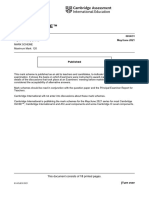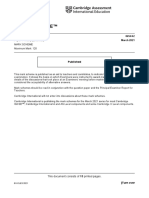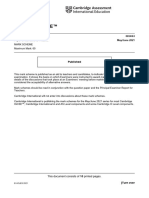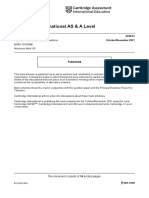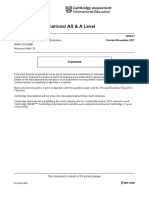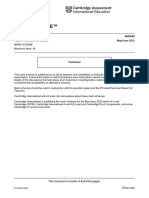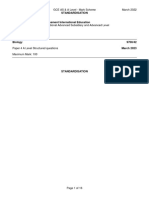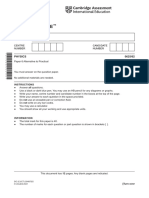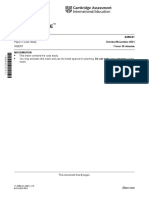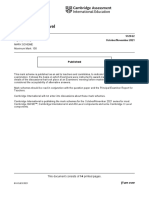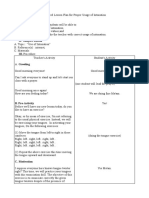Cambridge IGCSE™: Physics 0625/62 October/November 2021
Cambridge IGCSE™: Physics 0625/62 October/November 2021
Uploaded by
EffCopyright:
Available Formats
Cambridge IGCSE™: Physics 0625/62 October/November 2021
Cambridge IGCSE™: Physics 0625/62 October/November 2021
Uploaded by
EffOriginal Title
Copyright
Available Formats
Share this document
Did you find this document useful?
Is this content inappropriate?
Copyright:
Available Formats
Cambridge IGCSE™: Physics 0625/62 October/November 2021
Cambridge IGCSE™: Physics 0625/62 October/November 2021
Uploaded by
EffCopyright:
Available Formats
Cambridge IGCSE™
PHYSICS 0625/62
Paper 6 Alternative to Practical October/November 2021
MARK SCHEME
Maximum Mark: 40
Published
This mark scheme is published as an aid to teachers and candidates, to indicate the requirements of the
examination. It shows the basis on which Examiners were instructed to award marks. It does not indicate the
details of the discussions that took place at an Examiners’ meeting before marking began, which would have
considered the acceptability of alternative answers.
Mark schemes should be read in conjunction with the question paper and the Principal Examiner Report for
Teachers.
Cambridge International will not enter into discussions about these mark schemes.
Cambridge International is publishing the mark schemes for the October/November 2021 series for most
Cambridge IGCSE™, Cambridge International A and AS Level components and some Cambridge O Level
components.
This document consists of 12 printed pages.
© UCLES 2021 [Turn over
0625/62 Cambridge IGCSE – Mark Scheme October/November 2021
PUBLISHED
Generic Marking Principles
These general marking principles must be applied by all examiners when marking candidate answers. They should be applied alongside the
specific content of the mark scheme or generic level descriptors for a question. Each question paper and mark scheme will also comply with these
marking principles.
GENERIC MARKING PRINCIPLE 1:
Marks must be awarded in line with:
• the specific content of the mark scheme or the generic level descriptors for the question
• the specific skills defined in the mark scheme or in the generic level descriptors for the question
• the standard of response required by a candidate as exemplified by the standardisation scripts.
GENERIC MARKING PRINCIPLE 2:
Marks awarded are always whole marks (not half marks, or other fractions).
GENERIC MARKING PRINCIPLE 3:
Marks must be awarded positively:
• marks are awarded for correct/valid answers, as defined in the mark scheme. However, credit is given for valid answers which go beyond the
scope of the syllabus and mark scheme, referring to your Team Leader as appropriate
• marks are awarded when candidates clearly demonstrate what they know and can do
• marks are not deducted for errors
• marks are not deducted for omissions
• answers should only be judged on the quality of spelling, punctuation and grammar when these features are specifically assessed by the
question as indicated by the mark scheme. The meaning, however, should be unambiguous.
GENERIC MARKING PRINCIPLE 4:
Rules must be applied consistently, e.g. in situations where candidates have not followed instructions or in the application of generic level
descriptors.
© UCLES 2021 Page 2 of 12
0625/62 Cambridge IGCSE – Mark Scheme October/November 2021
PUBLISHED
GENERIC MARKING PRINCIPLE 5:
Marks should be awarded using the full range of marks defined in the mark scheme for the question (however; the use of the full mark range may
be limited according to the quality of the candidate responses seen).
GENERIC MARKING PRINCIPLE 6:
Marks awarded are based solely on the requirements as defined in the mark scheme. Marks should not be awarded with grade thresholds or
grade descriptors in mind.
Science-Specific Marking Principles
1 Examiners should consider the context and scientific use of any keywords when awarding marks. Although keywords may be present, marks
should not be awarded if the keywords are used incorrectly.
2 The examiner should not choose between contradictory statements given in the same question part, and credit should not be awarded for any
correct statement that is contradicted within the same question part. Wrong science that is irrelevant to the question should be ignored.
3 Although spellings do not have to be correct, spellings of syllabus terms must allow for clear and unambiguous separation from other syllabus
terms with which they may be confused (e.g. ethane / ethene, glucagon / glycogen, refraction / reflection).
4 The error carried forward (ecf) principle should be applied, where appropriate. If an incorrect answer is subsequently used in a scientifically
correct way, the candidate should be awarded these subsequent marking points. Further guidance will be included in the mark scheme where
necessary and any exceptions to this general principle will be noted.
5 ‘List rule’ guidance
For questions that require n responses (e.g. State two reasons …):
• The response should be read as continuous prose, even when numbered answer spaces are provided.
• Any response marked ignore in the mark scheme should not count towards n.
• Incorrect responses should not be awarded credit but will still count towards n.
• Read the entire response to check for any responses that contradict those that would otherwise be credited. Credit should not be
awarded for any responses that are contradicted within the rest of the response. Where two responses contradict one another, this should
be treated as a single incorrect response.
• Non-contradictory responses after the first n responses may be ignored even if they include incorrect science.
© UCLES 2021 Page 3 of 12
0625/62 Cambridge IGCSE – Mark Scheme October/November 2021
PUBLISHED
6 Calculation specific guidance
Correct answers to calculations should be given full credit even if there is no working or incorrect working, unless the question states ‘show
your working’.
For questions in which the number of significant figures required is not stated, credit should be awarded for correct answers when rounded by
the examiner to the number of significant figures given in the mark scheme. This may not apply to measured values.
For answers given in standard form (e.g. a × 10n) in which the convention of restricting the value of the coefficient (a) to a value between 1
and 10 is not followed, credit may still be awarded if the answer can be converted to the answer given in the mark scheme.
Unless a separate mark is given for a unit, a missing or incorrect unit will normally mean that the final calculation mark is not awarded.
Exceptions to this general principle will be noted in the mark scheme.
7 Guidance for chemical equations
Multiples / fractions of coefficients used in chemical equations are acceptable unless stated otherwise in the mark scheme.
State symbols given in an equation should be ignored unless asked for in the question or stated otherwise in the mark scheme.
© UCLES 2021 Page 4 of 12
0625/62 Cambridge IGCSE – Mark Scheme October/November 2021
PUBLISHED
Examples of how to apply the list rule
State three reasons…. [3]
A 1 Correct F 1 Correct
2 Correct 2 (4 responses) 2 Correct
2
3 Wrong 3 Correct
CON (of 3.) (discount 3)
B 1 Correct, Correct ,
G 1 Correct
(4 responses) 2 Correct 3
(5 responses) 2 Correct
3 Wrong ignore
3
3 Correct
Correct ignore
CON (of 4.) ignore
C 1 Correct
(4 responses) 2 Correct, Wrong , 2
3 Correct ignore H 1 Correct
(4 responses) 2 Correct
2
3 CON (of 2.) (discount 2)
D 1 Correct
Correct
(4 responses) 2 Correct, CON , (discount 2)
2
(of 2.)
3 Correct I 1 Correct
(4 responses) 2 Correct
2
3 Correct
E 1 Correct
CON (of 2.) (discount 2)
(4 responses) 2 Correct 3
3 Correct, Wrong
© UCLES 2021 Page 5 of 12
0625/62 Cambridge IGCSE – Mark Scheme October/November 2021
PUBLISHED
RM Assessor 3 annotations:
annotation suggested use annotation suggested use
tick mark awarded (note the ticks are added up next wavy line used to highlight a particular point
to the tick annotation, check the total you enter (horizontal or
agrees) vertical)
cross no mark awarded CON contradiction
SEEN indicates page seen
BOD benefit of doubt given NAQ not answered question
NBOD no benefit of doubt given PD poor diagram
on page comment gives a text box to write comment –much easier SF error in number of significant figures
to use than in the previous version of RM significant figure error not penalized.
assessor SFSF
POT power-of-ten error
POT POT POT penalty not applied as already applied
ECF error carried forward TV too vague
^ omission mark I ignore
? unclear
U unit penalty applied SC special case
UU unit penalty not applied because already applied
earlier in same question
© UCLES 2021 Page 6 of 12
0625/62 Cambridge IGCSE – Mark Scheme October/November 2021
PUBLISHED
NOTES ABOUT MARK SCHEME SYMBOLS AND OTHER MATTERS
Brackets ( ) Brackets around words or units in the mark scheme are intended to indicate wording used to clarify the mark scheme, but the
marks do not depend on seeing the words or units in brackets, e.g. 10 (J) means that the mark is scored for 10, regardless of
the unit given. However, if a word in brackets is replaced with another word that is clearly wrong then the mark should not be
awarded.
Underlining Underlining indicates that this must be seen in the answer offered, or something very similar.
OR / or This indicates alternative answers, any one of which is satisfactory for scoring the marks.
eeoo. This means "each error or omission".
owtte. This means “or words to that effect”.
Ignore This indicates that something which is not correct or irrelevant i.e. it is not a contradiction (CON) is to be disregarded and does
not incur a penalty.
Spelling Be generous about spelling and use of English. If an answer can be understood to mean what we want, give credit. However,
do not allow ambiguities, e.g. spelling which suggests confusion between reflection / refraction / diffraction or
thermistor / transistor / transformer.
Not/NOT This indicates that an incorrect answer is not to be disregarded, but cancels another otherwise correct alternative offered by
the candidate, i.e. right plus wrong penalty applies.
ecf meaning "error carried forward" is mainly applicable to numerical questions, but may in particular circumstances be applied in
non-numerical questions. This indicates that if a candidate has made an earlier mistake and has carried an incorrect value
forward to subsequent stages of working, marks indicated by ecf may be awarded, provided the subsequent working is correct,
bearing in mind the earlier mistake. This prevents a candidate from being penalised more than once for a particular mistake,
but only applies to marks annotated ecf in the mark scheme. Always annotate ecf if applied.
cao correct answer only
Use of NR (# or / key on the keyboard). Use this if the answer space for a question is completely blank or contains no readable words,
figures or symbols.
© UCLES 2021 Page 7 of 12
0625/62 Cambridge IGCSE – Mark Scheme October/November 2021
PUBLISHED
Question Answer Marks
1(a)(i) l = 5.1 (cm) and w = 4.7 (cm) 1
1(a)(ii) V = 95.88 (cm3) 1
1(a)(iii) 64 (g) 1
1(a)(iv) ρ to 2 or 3 significant figures 1
unit g / cm3 1
1(b)(i) estimate of V1 given to the nearest cm3 and > ½V < V 1
1(b)(ii) mW numerically equal to V1 1
1(c)(i) d = candidate’s (a)(iii) − (b)(ii) correct 1
1(c)(ii) YES/NO and suitable comparison of d with m or mW 1
1(d) (float wood and) mark water level / remove and mark the water level 1
measure submerged depth and multiply by the cross-sectional area 1
OR
measure height of block that is not submerged (1)
multiply by the cross-sectional area then subtract from total volume of block. (1)
OR
use of a measuring cylinder / displacement can (1)
measure the volume of water displaced (by the floating block) (1)
© UCLES 2021 Page 8 of 12
0625/62 Cambridge IGCSE – Mark Scheme October/November 2021
PUBLISHED
Question Answer Marks
2(a)(i) VS = 1.8(0) 1
IS = 0.38 1
2(a)(ii) RS = 4.7 (4.7368) 1
units Ω, V, A seen 1
2(b) RL = 4.86 (Ω) 1
to 2 or 3 significant figures 1
2(c) symbols correct 1
resistor and lamp in series, with voltmeter in parallel with both 1
2(d) RC = 8.1 (8.0952) (Ω) 1
2(e) statement to match results – expect NO 1
explanation of idea of beyond limits of experimental accuracy (e.g., values not close (enough)/too far apart/> 10% difference 1
© UCLES 2021 Page 9 of 12
0625/62 Cambridge IGCSE – Mark Scheme October/November 2021
PUBLISHED
Question Answer Marks
3(a) u / v = 0.25 1
3(b) axes correctly labelled with quantity and unit and right way round 1
suitable scales with u axis starting at 15.0 1
all plots correct to ½ small square 1
good line judgement, thin, continuous line 1
3(c) method clearly shown on graph 1
value correct to within ½ small square 1
3(d) Correct value for f – candidate’s (c) ÷ 2 1
to 2 or 3 significant figures 1
© UCLES 2021 Page 10 of 12
0625/62 Cambridge IGCSE – Mark Scheme October/November 2021
PUBLISHED
Question Answer Marks
3(e) Read both parts of the answer together and award the marks in either order
deciding the screen position for most clearly focused image 1
move screen slowly / backwards and forwards 1
OR
the image is difficult to see (1)
carry out in a darkened room / away from bright lights (1)
OR
(metre) rule moving (1)
clamp rule / tape rule to bench (1)
OR
the image is (small and) difficult to focus (1)
use a bigger object (1)
OR
difficult to find the centre of the lens (1)
use a marked lens holder (1)
OR
object, (centre of) lens (and screen) are not at the same height above the bench (1)
use a ruler / set-square to check (1)
© UCLES 2021 Page 11 of 12
0625/62 Cambridge IGCSE – Mark Scheme October/November 2021
PUBLISHED
Question Answer Marks
4 MP1 method 1
names of at least three metals / named alloys suggested
MP2 add loads / masses to test wire until it breaks 1
MP3 repeat with the other metals 1
MP4 repeat for each individual metal wire (and take an average) 1
MP5 control variable 1
diameter / cross-sectional area/thickness of the wire
MP6 table 1
columns for metal / wire and load / mass / weight, with unit
MP7 conclusion 1
compare breaking force / load / weight to metal
OR plot a bar chart of metal and breaking force / load weight
Additional graph notes:
NOTE: The principle to apply here is ‘could I draw a significantly better line, using these points, under examination conditions?’ If the answer is
definitely ‘yes’, do not award the mark.
NOTE: – If candidate’s scale consists of actual readings at equal intervals this will produce a perfect straight line! The only mark available in this
case is the first (axes right way round and labelled) So maximum 1.
– If axes are wrong way round, the other 3 marks are still available.
© UCLES 2021 Page 12 of 12
You might also like
- Cambridge IGCSE: First Language English 0500/21Document4 pagesCambridge IGCSE: First Language English 0500/21EffNo ratings yet
- Regents Exams and Answers Geometry Revised EditionFrom EverandRegents Exams and Answers Geometry Revised EditionNo ratings yet
- Handbook All How To Measure PerformanceDocument186 pagesHandbook All How To Measure Performancetatamcute90% (10)
- A Handful of Dates Lesson PlanDocument6 pagesA Handful of Dates Lesson PlanEunice Kryna Verula100% (1)
- Cambridge IGCSE™: Physics 0625/62 October/November 2021Document12 pagesCambridge IGCSE™: Physics 0625/62 October/November 2021Manya PunjabiNo ratings yet
- Cambridge IGCSE™: Physics 0625/41 October/November 2021Document18 pagesCambridge IGCSE™: Physics 0625/41 October/November 2021Manya PunjabiNo ratings yet
- Cambridge IGCSE™: Physics 0625/63 October/November 2021Document11 pagesCambridge IGCSE™: Physics 0625/63 October/November 2021Manya PunjabiNo ratings yet
- Cambridge IGCSE™: Physics 0625/42 October/November 2021Document16 pagesCambridge IGCSE™: Physics 0625/42 October/November 2021Manya PunjabiNo ratings yet
- Cambridge IGCSE™: Physics 0625/42 October/November 2021Document16 pagesCambridge IGCSE™: Physics 0625/42 October/November 2021EffNo ratings yet
- Cambridge IGCSE™: Physics 0625/63 October/November 2021Document11 pagesCambridge IGCSE™: Physics 0625/63 October/November 2021Vidhi ChhedaNo ratings yet
- Cambridge IGCSE™: Physics 0625/31 October/November 2021Document14 pagesCambridge IGCSE™: Physics 0625/31 October/November 2021mohamed.emad.2010.m31No ratings yet
- Cambridge IGCSE™: Physics 0625/61 October/November 2021Document11 pagesCambridge IGCSE™: Physics 0625/61 October/November 2021Manya PunjabiNo ratings yet
- 0654_s21_ms_53Document10 pages0654_s21_ms_53damarukeshwarattitudeNo ratings yet
- Cambridge IGCSE™: Co-Ordinated Sciences 0654/42 May/June 2022Document14 pagesCambridge IGCSE™: Co-Ordinated Sciences 0654/42 May/June 2022Khoa DangNo ratings yet
- Cambridge International AS & A Level: Physics 9702/COMP March 2021Document13 pagesCambridge International AS & A Level: Physics 9702/COMP March 2021Osama Mehmood TariqNo ratings yet
- 0654_s21_ms_62Document12 pages0654_s21_ms_62damarukeshwarattitudeNo ratings yet
- Cambridge IGCSE™: Co-Ordinated Sciences 0654/62 October/November 2021Document11 pagesCambridge IGCSE™: Co-Ordinated Sciences 0654/62 October/November 2021Anh Nguyễn VănNo ratings yet
- Cambridge IGCSE™: Physics 0625/32 October/November 2021Document14 pagesCambridge IGCSE™: Physics 0625/32 October/November 2021Helena ShanghetaNo ratings yet
- Cambridge IGCSE™: Physics 0625/43 October/November 2021Document16 pagesCambridge IGCSE™: Physics 0625/43 October/November 2021Manya PunjabiNo ratings yet
- Cambridge International AS & A Level: Physics 9702/22 February/March 2022Document12 pagesCambridge International AS & A Level: Physics 9702/22 February/March 2022Simran PradhanNo ratings yet
- Number 1 (0654 - s21 - Ms - 42)Document13 pagesNumber 1 (0654 - s21 - Ms - 42)Muhammad Luthfansyah PrabowoNo ratings yet
- 0654_s21_ms_31Document13 pages0654_s21_ms_31damarukeshwarattitudeNo ratings yet
- 0654_s21_ms_33Document13 pages0654_s21_ms_33damarukeshwarattitudeNo ratings yet
- Cambridge International AS & A Level: Chemistry 9701/52 October/November 2020Document8 pagesCambridge International AS & A Level: Chemistry 9701/52 October/November 2020bloomNo ratings yet
- Cambridge IGCSE™: Physics 0625/32 May/June 2022Document12 pagesCambridge IGCSE™: Physics 0625/32 May/June 2022Gisela NixieNo ratings yet
- Cambridge IGCSE™: Chemistry 0620/61 May/June 2021Document9 pagesCambridge IGCSE™: Chemistry 0620/61 May/June 2021Mina Abdou100% (1)
- Cambridge IGCSE™: Co-Ordinated Sciences 0654/42 March 2021Document13 pagesCambridge IGCSE™: Co-Ordinated Sciences 0654/42 March 2021Inga NaranbatNo ratings yet
- Cambridge International AS & A Level: Biology 9700/52 May/June 2021Document11 pagesCambridge International AS & A Level: Biology 9700/52 May/June 2021looper360.mrNo ratings yet
- 0654_s21_ms_63Document10 pages0654_s21_ms_63damarukeshwarattitudeNo ratings yet
- Cambridge IGCSE™: Chemistry 0620/63 May/June 2021Document8 pagesCambridge IGCSE™: Chemistry 0620/63 May/June 2021Manya PunjabiNo ratings yet
- Cambridge IGCSE™: Physics 0625/31 May/June 2022Document13 pagesCambridge IGCSE™: Physics 0625/31 May/June 2022abdulrahmanhagag1No ratings yet
- Cambridge International AS & A Level: Biology 9700/53 May/June 2022Document10 pagesCambridge International AS & A Level: Biology 9700/53 May/June 2022owencandra11No ratings yet
- Cambridge International AS & A Level: Biology 9700/51 May/June 2021Document10 pagesCambridge International AS & A Level: Biology 9700/51 May/June 2021drnourelserafyNo ratings yet
- Cambridge International AS & A Level: Biology 9700/53 May/June 2021Document11 pagesCambridge International AS & A Level: Biology 9700/53 May/June 2021YeNo ratings yet
- Cambridge IGCSE™: Chemistry 0620/62 October/November 2020Document8 pagesCambridge IGCSE™: Chemistry 0620/62 October/November 2020tatiananeshazNo ratings yet
- Cambridge International AS & A Level: Physics 9702/42 February/March 2022Document17 pagesCambridge International AS & A Level: Physics 9702/42 February/March 2022Pom GNo ratings yet
- Cambridge International AS & A Level: Physics 9702/42 March 2021Document19 pagesCambridge International AS & A Level: Physics 9702/42 March 2021chana.wichernNo ratings yet
- Cambridge IGCSE™: Chemistry 0620/63Document9 pagesCambridge IGCSE™: Chemistry 0620/63Ora MattNo ratings yet
- Cambridge International AS & A Level: Biology 9700/52 October/November 2021Document11 pagesCambridge International AS & A Level: Biology 9700/52 October/November 2021lllllisaNo ratings yet
- Cambridge International AS & A Level: Biology 9700/21 October/November 2021Document16 pagesCambridge International AS & A Level: Biology 9700/21 October/November 2021lllllisaNo ratings yet
- Cambridge International AS & A Level: Biology 9700/52 October/November 2020Document11 pagesCambridge International AS & A Level: Biology 9700/52 October/November 2020Abdul RehmanNo ratings yet
- Cambridge International AS & A Level: Biology 9700/51 October/November 2021Document11 pagesCambridge International AS & A Level: Biology 9700/51 October/November 2021lllllisaNo ratings yet
- Cambridge International AS & A Level: BiologyDocument21 pagesCambridge International AS & A Level: BiologylllllisaNo ratings yet
- Cambridge IGCSE™: Chemistry 0620/63Document9 pagesCambridge IGCSE™: Chemistry 0620/63kamsi.nnonaNo ratings yet
- Cambridge International AS & A Level: Biology 9700/22 May/June 2022Document21 pagesCambridge International AS & A Level: Biology 9700/22 May/June 2022Patience BhebheNo ratings yet
- 11_0653_41_MS_prov_rma_21102024034758Document15 pages11_0653_41_MS_prov_rma_21102024034758ethansancho10No ratings yet
- Cambridge International AS & A Level: Biology 9700/53Document13 pagesCambridge International AS & A Level: Biology 9700/53priscillia.sapuletteNo ratings yet
- Cambridge International AS & A Level: Chemistry 9701/33 October/November 2022Document11 pagesCambridge International AS & A Level: Chemistry 9701/33 October/November 2022Muhammad Subhani IqbalNo ratings yet
- Cambridge International AS & A Level: Chemistry 9701/33 October/November 2022Document11 pagesCambridge International AS & A Level: Chemistry 9701/33 October/November 2022momoNo ratings yet
- Cambridge International AS & A Level: Chemistry 9701/22 October/November 2022Document13 pagesCambridge International AS & A Level: Chemistry 9701/22 October/November 2022Jjuuko JeremiahNo ratings yet
- Cambridge IGCSE™: Updated Post Vetting July 2023Document12 pagesCambridge IGCSE™: Updated Post Vetting July 2023shukla.abheekNo ratings yet
- Cambridge International AS & A Level: Biology 9700/51Document12 pagesCambridge International AS & A Level: Biology 9700/51priscillia.sapuletteNo ratings yet
- Cambridge IGCSE™: Updated Post Vetting July 2023Document12 pagesCambridge IGCSE™: Updated Post Vetting July 2023alyazia6163No ratings yet
- Cambridge International AS & A Level: Physics 9702/22 March 2020Document14 pagesCambridge International AS & A Level: Physics 9702/22 March 2020Wisdom Wealth English Junior Council [IN020]No ratings yet
- Cambridge International AS & A Level: Biology 9700/21 October/November 2022Document17 pagesCambridge International AS & A Level: Biology 9700/21 October/November 2022Milinda De SilvaNo ratings yet
- Cambridge International AS & A Level: Biology 9700/22 October/November 2022Document20 pagesCambridge International AS & A Level: Biology 9700/22 October/November 2022Milinda De SilvaNo ratings yet
- Cambridge IGCSE™: Chemistry 0620/62 May/June 2021Document8 pagesCambridge IGCSE™: Chemistry 0620/62 May/June 2021platosplanetdubaiNo ratings yet
- Cambridge International AS & A Level: Biology 9700/22 October/November 2022Document20 pagesCambridge International AS & A Level: Biology 9700/22 October/November 2022ellenahmed83179No ratings yet
- Paper 4 2023 MsDocument16 pagesPaper 4 2023 Msadel hanyNo ratings yet
- 0620 - w23 - Ms - 61 PaperDocument8 pages0620 - w23 - Ms - 61 Papersinghnidhi.dNo ratings yet
- Cambridge International General Certificate of Secondary EducationDocument15 pagesCambridge International General Certificate of Secondary EducationSandra AtefNo ratings yet
- Cambridge International AS & A Level: Biology 9700/52Document13 pagesCambridge International AS & A Level: Biology 9700/52Harris SusantoNo ratings yet
- Bio 103Document20 pagesBio 103mohsen400No ratings yet
- Cambridge IGCSE™: Literature in English 0475/12 October/November 2021Document4 pagesCambridge IGCSE™: Literature in English 0475/12 October/November 2021EffNo ratings yet
- Practice Questions On DifferentiationDocument1 pagePractice Questions On DifferentiationEffNo ratings yet
- Cambridge IGCSE: Information and Communication Technology 0417/02Document12 pagesCambridge IGCSE: Information and Communication Technology 0417/02EffNo ratings yet
- Cambridge IGCSE: Literature in English 0475/12Document28 pagesCambridge IGCSE: Literature in English 0475/12EffNo ratings yet
- Cambridge IGCSE: Literature in English 0475/22Document12 pagesCambridge IGCSE: Literature in English 0475/22EffNo ratings yet
- Cambridge IGCSE™: Information & Communication Technology 0417/02 October/November 2021Document17 pagesCambridge IGCSE™: Information & Communication Technology 0417/02 October/November 2021EffNo ratings yet
- Cambridge IGCSE™: Biology 0610/62 October/November 2021Document9 pagesCambridge IGCSE™: Biology 0610/62 October/November 2021EffNo ratings yet
- Cambridge IGCSE™: Information & Communication Technology 0417/12 October/November 2021Document9 pagesCambridge IGCSE™: Information & Communication Technology 0417/12 October/November 2021EffNo ratings yet
- Cambridge IGCSE™: Information & Communication Technology 0417/03 October/November 2021Document10 pagesCambridge IGCSE™: Information & Communication Technology 0417/03 October/November 2021EffNo ratings yet
- Conducting Cambridge IGCSE ICT (0417) Practical Tests November 2021Document7 pagesConducting Cambridge IGCSE ICT (0417) Practical Tests November 2021EffNo ratings yet
- Cambridge IGCSE: Information and Communication Technology 0417/03Document8 pagesCambridge IGCSE: Information and Communication Technology 0417/03EffNo ratings yet
- Cambridge IGCSE™: First Language EnglishDocument19 pagesCambridge IGCSE™: First Language EnglishEff100% (1)
- Cambridge IGCSE: First Language English 0500/21Document12 pagesCambridge IGCSE: First Language English 0500/21EffNo ratings yet
- Functions The Basics Answers MMEDocument1 pageFunctions The Basics Answers MMEEffNo ratings yet
- Cambridge IGCSE: PHYSICS 0625/62Document12 pagesCambridge IGCSE: PHYSICS 0625/62EffNo ratings yet
- Cambridge IGCSE: 0450/21 Business StudiesDocument4 pagesCambridge IGCSE: 0450/21 Business StudiesEffNo ratings yet
- Cambridge IGCSE™: Physics 0625/22 October/November 2021Document3 pagesCambridge IGCSE™: Physics 0625/22 October/November 2021Eff100% (1)
- Solids, Liquids and GasesDocument2 pagesSolids, Liquids and GasesEff100% (2)
- Cambridge IGCSE: PHYSICS 0625/42Document16 pagesCambridge IGCSE: PHYSICS 0625/42EffNo ratings yet
- 0620 - 0971 - Ext - OTG - Marking FeedbackDocument15 pages0620 - 0971 - Ext - OTG - Marking FeedbackEffNo ratings yet
- Functions Harder Questions MMEDocument6 pagesFunctions Harder Questions MMEEffNo ratings yet
- GCSE Maths Revision Functions AnswersDocument4 pagesGCSE Maths Revision Functions AnswersEffNo ratings yet
- Solids, Liquids and Gases Quick Assessment: State of Matter Before State of Matter AfterDocument3 pagesSolids, Liquids and Gases Quick Assessment: State of Matter Before State of Matter AfterEffNo ratings yet
- Waec SC Time Table (Senior) : DAY Date Code Paper Title Subject Duration TimeDocument2 pagesWaec SC Time Table (Senior) : DAY Date Code Paper Title Subject Duration TimeEffNo ratings yet
- #Solids Liquids and Gases Teaching IdeasDocument2 pages#Solids Liquids and Gases Teaching IdeasEffNo ratings yet
- DLP For Eng8 Q4-M2Document12 pagesDLP For Eng8 Q4-M2Rachelle Marie AlejandroNo ratings yet
- Neurosemantics: The Psychology of 18 WFO (Well Formed Outcome)Document5 pagesNeurosemantics: The Psychology of 18 WFO (Well Formed Outcome)numuaiNo ratings yet
- Photocopiable Activities Overview: GrammarDocument25 pagesPhotocopiable Activities Overview: GrammarBogi OrbanNo ratings yet
- Cambridge O Level: Combined Science 5129/22 October/November 2021Document14 pagesCambridge O Level: Combined Science 5129/22 October/November 2021For GamingNo ratings yet
- How To Handle ObjectionsDocument56 pagesHow To Handle ObjectionsMichael Flotildes100% (1)
- Present Simple ExercisesDocument6 pagesPresent Simple ExercisesWìlinton CastañedaNo ratings yet
- book (2) 전체Document412 pagesbook (2) 전체toolbarmanNo ratings yet
- Ebook - Question MasteryDocument25 pagesEbook - Question MasterySanjay KumarNo ratings yet
- An Essay FormatDocument15 pagesAn Essay FormatHarjot BrarNo ratings yet
- HR Interview Questions & AnswersDocument19 pagesHR Interview Questions & Answersraj_saranNo ratings yet
- Framing Your Research Question: Dr. Sharif AbbasiDocument21 pagesFraming Your Research Question: Dr. Sharif Abbasiameeque khaskheli100% (1)
- Persuasive Writing - Advertisement - Model Analysis PDFDocument4 pagesPersuasive Writing - Advertisement - Model Analysis PDFRachelleChellaBarnardNo ratings yet
- Free geography-WPS OfficeDocument2 pagesFree geography-WPS OfficeHanifa Barrera0% (1)
- O'Leary and Creswell Chapter TwoDocument24 pagesO'Leary and Creswell Chapter TwoLindsay R. Calhoun100% (1)
- Taking The Password Pupil Knowledge and Writing Test January 2021Document23 pagesTaking The Password Pupil Knowledge and Writing Test January 2021Natasha AbaevaNo ratings yet
- Match The Following - Study NotesDocument9 pagesMatch The Following - Study Notessanjay nihalNo ratings yet
- Grammar Question TagsDocument4 pagesGrammar Question TagsMarini BudiartiNo ratings yet
- 25 Most Difficult Questions 559Document6 pages25 Most Difficult Questions 559shana2309aNo ratings yet
- 4PA0 01 Pef 20150819 PDFDocument6 pages4PA0 01 Pef 20150819 PDFNourNo ratings yet
- Lesson Plan - IntonationDocument4 pagesLesson Plan - IntonationJames Carl ZaoldyeckNo ratings yet
- Questionnaire On Personal Information 1Document5 pagesQuestionnaire On Personal Information 1Zafar AkhtarNo ratings yet
- Stuent's-Practice - b1.3 - 25% N I Dung Thi MidtermDocument25 pagesStuent's-Practice - b1.3 - 25% N I Dung Thi Midtermnguyenrin687No ratings yet
- Toefl Test of English As A Foreign Language Speaking TPO Practice Lesson 7Document16 pagesToefl Test of English As A Foreign Language Speaking TPO Practice Lesson 7Jean TeofiloNo ratings yet
- Ip Grade 2 Fourth QDocument19 pagesIp Grade 2 Fourth QJoefilNo ratings yet
- "Any Questions" Investigating The Nature of Understanding-Checks in The Language ClassroomDocument31 pages"Any Questions" Investigating The Nature of Understanding-Checks in The Language ClassroomNgoc Long VuNo ratings yet
- Wipro Questions and AnswersDocument3 pagesWipro Questions and AnswerssudharsanankNo ratings yet
- These Top 10 Classroom Games Provide Fun Ways To Engage Your Students in Academic LearningDocument21 pagesThese Top 10 Classroom Games Provide Fun Ways To Engage Your Students in Academic LearningEmmaNo ratings yet
- Unit 5Document13 pagesUnit 5AlerigNo ratings yet





















